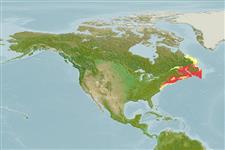>
Perciformes/Cottoidei (Sculpins) >
Agonidae (Poachers) > Hemitripterinae
Etymology: Hemitripterus: Greek, hemi = half + Greek, tres, tria = three + Greek, pteron = wing, fin (Ref. 45335).
More on author: Gmelin.
Environment: milieu / climate zone / depth range / distribution range
Ecología
marino demersal; rango de profundidad 2 - 180 m. Temperate; ? - 16°C (Ref. 27549); 58°N - 36°N, 76°W - 50°W
Northwest Atlantic: Labrador in Canada to Chesapeake Bay in USA.
Tamaño / Peso / Age
Maturity: Lm ? range ? - ? cm
Max length : 68.0 cm TL macho / no sexado; (Ref. 49746); peso máximo publicado: 3.2 kg (Ref. 7251)
Inhabit rocky or hard bottom and is a voracious eater. Food includes crustaceans, mollusks, sea urchins, fishes such as herring, sand lance and silver hake, and any bottom invertebrates that are available. When taken out of the water the belly becomes inflated so that when returned to the water they are unable to submerge. Adults attach their eggs near the base of a sponge to use as a spawning bed (Ref. 34819, 41075).
Life cycle and mating behavior
Madurez | Reproducción | Puesta | Huevos | Fecundidad | Larva
Adults attach their eggs near the base of a sponge to use as a spawning bed (Ref. 34819, 41075).
Robins, C.R. and G.C. Ray, 1986. A field guide to Atlantic coast fishes of North America. Houghton Mifflin Company, Boston, U.S.A. 354 p. (Ref. 7251)
IUCN Red List Status (Ref. 130435: Version 2024-2)
Threat to humans
Harmless
Human uses
Pesca deportiva: si; carnada: occasionally
Herramientas
Special reports
Download XML
Fuentes de Internet
Estimates based on models
Preferred temperature (Ref.
123201): 0.5 - 10.2, mean 3.8 °C (based on 130 cells).
Phylogenetic diversity index (Ref.
82804): PD
50 = 0.6289 [Uniqueness, from 0.5 = low to 2.0 = high].
Bayesian length-weight: a=0.00794 (0.00578 - 0.01091), b=3.19 (3.10 - 3.28), in cm total length, based on LWR estimates for this species (Ref.
93245).
Nivel trófico (Ref.
69278): 4.5 ±0.5 se; based on diet studies.
Resiliencia (Ref.
120179): Muy bajo, población duplicada en un tiempo mínimo superior a 14 años (Preliminary K or Fecundity.).
Fishing Vulnerability (Ref.
59153): Moderate to high vulnerability (47 of 100).
Nutrients (Ref.
124155): Calcium = 32.1 [17.3, 64.8] mg/100g; Iron = 0.341 [0.174, 0.650] mg/100g; Protein = 17.2 [15.9, 18.5] %; Omega3 = 0.575 [0.254, 1.525] g/100g; Selenium = 17.2 [8.4, 40.8] μg/100g; VitaminA = 24.2 [7.4, 79.7] μg/100g; Zinc = 0.423 [0.300, 0.618] mg/100g (wet weight);
